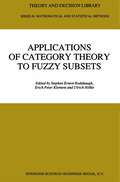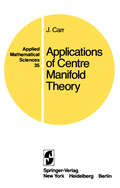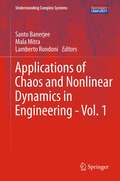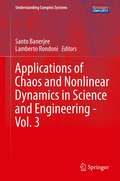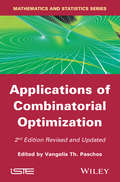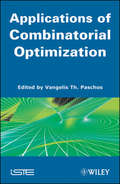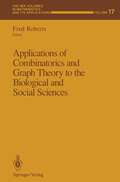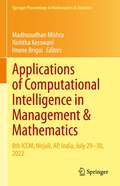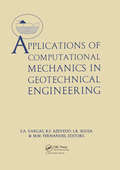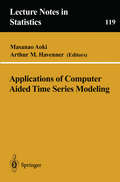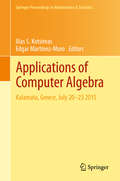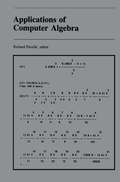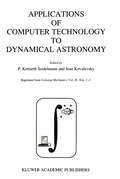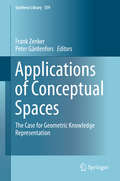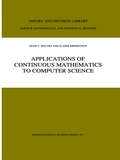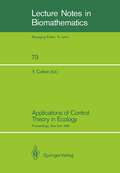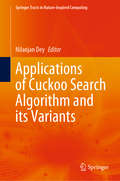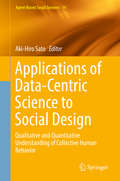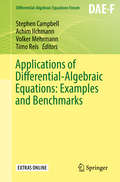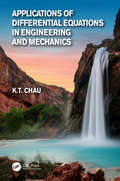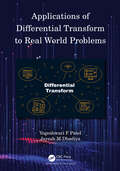- Table View
- List View
Applications of Category Theory to Fuzzy Subsets (Theory and Decision Library B #14)
by S. E. Rodabaugh Erich Peter Klement Ulrich HöhleThis book has a fundamental relationship to the International Seminar on Fuzzy Set Theory held each September in Linz, Austria. First, this volume is an extended account of the eleventh Seminar of 1989. Second, and more importantly, it is the culmination of the tradition of the preceding ten Seminars. The purpose of the Linz Seminar, since its inception, was and is to foster the development of the mathematical aspects of fuzzy sets. In the earlier years, this was accomplished by bringing together for a week small grou ps of mathematicians in various fields in an intimate, focused environment which promoted much informal, critical discussion in addition to formal presentations. Beginning with the tenth Seminar, the intimate setting was retained, but each Seminar narrowed in theme; and participation was broadened to include both younger scholars within, and established mathematicians outside, the mathematical mainstream of fuzzy sets theory. Most of the material of this book was developed over the years in close association with the Seminar or influenced by what transpired at Linz. For much of the content, it played a crucial role in either stimulating this material or in providing feedback and the necessary screening of ideas. Thus we may fairly say that the book, and the eleventh Seminar to which it is directly related, are in many respects a culmination of the previous Seminars.
Applications of Centre Manifold Theory (Applied Mathematical Sciences #35)
by J. CarrThese notes are based on a series of lectures given in the Lefschetz Center for Dynamical Systems in the Division of Applied Mathematics at Brown University during the academic year 1978-79. The purpose of the lectures was to give an introduction to the applications of centre manifold theory to differential equations. Most of the material is presented in an informal fashion, by means of worked examples in the hope that this clarifies the use of centre manifold theory. The main application of centre manifold theory given in these notes is to dynamic bifurcation theory. Dynamic bifurcation theory is concerned with topological changes in the nature of the solutions of differential equations as para meters are varied. Such an example is the creation of periodic orbits from an equilibrium point as a parameter crosses a critical value. In certain circumstances, the application of centre manifold theory reduces the dimension of the system under investigation. In this respect the centre manifold theory plays the same role for dynamic problems as the Liapunov-Schmitt procedure plays for the analysis of static solutions. Our use of centre manifold theory in bifurcation problems follows that of Ruelle and Takens [57) and of Marsden and McCracken [51).
Applications of Chaos and Nonlinear Dynamics in Engineering - Vol. 1 (Understanding Complex Systems)
by Santo Banerjee, Mala Mitra and Lamberto RondoniChaos and nonlinear dynamics initially developed as a new emergent field with its foundation in physics and applied mathematics. The highly generic, interdisciplinary quality of the insights gained in the last few decades has spawned myriad applications in almost all branches of science and technology—and even well beyond. Wherever quantitative modeling and analysis of complex, nonlinear phenomena is required, chaos theory and its methods can play a key role. This volume concentrates on reviewing the most relevant contemporary applications of chaotic nonlinear systems as they apply to the various cutting-edge branches of engineering. The book covers the theory as applied to robotics, electronic and communication engineering (for example chaos synchronization and cryptography) as well as to civil and mechanical engineering, where its use in damage monitoring and control is explored). Featuring contributions from active and leading research groups, this collection is ideal both as a reference and as a ‘recipe book’ full of tried and tested, successful engineering applications
Applications of Chaos and Nonlinear Dynamics in Science and Engineering - Vol. 3 (Understanding Complex Systems)
by Santo Banerjee and Lamberto RondoniChaos and nonlinear dynamics initially developed as a new emergent field with its foundation in physics and applied mathematics. The highly generic, interdisciplinary quality of the insights gained in the last few decades has spawned myriad applications in almost all branches of science and technology—and even well beyond. Wherever quantitative modeling and analysis of complex, nonlinear phenomena is required, chaos theory and its methods can play a key role. This third volume concentrates on reviewing further relevant contemporary applications of chaotic nonlinear systems as they apply to the various cutting-edge branches of engineering. This encompasses, but is not limited to, topics such fluctuation relations and chaotic dynamics in physics, fractals and their applications in epileptic seizures, as well as chaos synchronization.Featuring contributions from active and leading research groups, this collection is ideal both as a reference and as a ‘recipe book’ full of tried and tested, successful engineering applications.
Applications of Combinatorial Optimization: Applications Of Combinatorial Optimization (2nd Edition)
by Vangelis PaschosCombinatorial optimization is a multidisciplinary scientific area, lying in the interface of three major scientific domains: mathematics, theoretical computer science and management. The three volumes of the Combinatorial Optimization series aim to cover a wide range of topics in this area. These topics also deal with fundamental notions and approaches as with several classical applications of combinatorial optimization. Concepts of Combinatorial Optimization, is divided into three parts: - On the complexity of combinatorial optimization problems, presenting basics about worst-case and randomized complexity; - Classical solution methods, presenting the two most-known methods for solving hard combinatorial optimization problems, that are Branch-and-Bound and Dynamic Programming; - Elements from mathematical programming, presenting fundamentals from mathematical programming based methods that are in the heart of Operations Research since the origins of this field.
Applications of Combinatorial Optimization (Iste Ser.)
by Vangelis Th. PaschosCombinatorial optimization is a multidisciplinary scientific area, lying in the interface of three major scientific domains: mathematics, theoretical computer science and management. The three volumes of the Combinatorial Optimization series aims to cover a wide range of topics in this area. These topics also deal with fundamental notions and approaches as with several classical applications of combinatorial optimization. “Applications of Combinatorial Optimization” is presenting a certain number among the most common and well-known applications of Combinatorial Optimization.
Applications of Combinatorial Optimization (Iste Ser.)
by Vangelis Th. PaschosCombinatorial optimization is a multidisciplinary scientific area, lying in the interface of three major scientific domains: mathematics, theoretical computer science and management. The three volumes of the Combinatorial Optimization series aim to cover a wide range of topics in this area. These topics also deal with fundamental notions and approaches as with several classical applications of combinatorial optimization. Concepts of Combinatorial Optimization, is divided into three parts: - On the complexity of combinatorial optimization problems, presenting basics about worst-case and randomized complexity; - Classical solution methods, presenting the two most-known methods for solving hard combinatorial optimization problems, that are Branch-and-Bound and Dynamic Programming; - Elements from mathematical programming, presenting fundamentals from mathematical programming based methods that are in the heart of Operations Research since the origins of this field.
Applications of Combinatorial Optimization
by Vangelis Th. PaschosCombinatorial optimization is a multidisciplinary scientific area, lying in the interface of three major scientific domains: mathematics, theoretical computer science and management. The three volumes of the Combinatorial Optimization series aims to cover a wide range of topics in this area. These topics also deal with fundamental notions and approaches as with several classical applications of combinatorial optimization. “Applications of Combinatorial Optimization” is presenting a certain number among the most common and well-known applications of Combinatorial Optimization.
Applications of Combinatorics and Graph Theory to the Biological and Social Sciences (The IMA Volumes in Mathematics and its Applications #17)
by Fred RobertsThis IMA Volume in Mathematics and its Applications Applications of Combinatorics and Graph Theory to the Biological and Social Sciences is based on the proceedings of a workshop which was an integral part of the 1987-88 IMA program on APPLIED COMBINATORICS. We are grateful to the Scientific Committee: Victor Klee (Chairman), Daniel Kleitman, Dijen Ray-Chaudhuri and Dennis Stanton for planning and implementing an exciting and stimulating year long program. We especially thank the Workshop Organizers, Joel Cohen and Fred Roberts, for organizing a workshop which brought together many of the major figures in a variety of research fields connected with the application of combinatorial ideas to the social and biological sciences. A vner Friedman Willard Miller APPLICATIONS OF COMBINATORICS AND GRAPH THEORY TO THE BIOLOGICAL AND SOCIAL SCIENCES: SEVEN FUNDAMENTAL IDEAS FRED S. RoBERTS* Abstract. To set the stage for the other papers in this volume, seven fundamental concepts which arise in the applications of combinatorics and graph theory in the biological and social sciences are described. These ideas are: RNA chains as "words" in a 4 letter alphabet; interval graphs; competition graphs or niche overlap graphs; qualitative stability; balanced signed graphs; social welfare functions; and semiorders. For each idea, some basic results are presented, some recent results are given, and some open problems are mentioned.
Applications of Computational Intelligence in Management & Mathematics: 8th ICCM, Nirjuli, AP, India, July 29–30, 2022 (Springer Proceedings in Mathematics & Statistics #417)
by Madhusudhan Mishra Nishtha Kesswani Imene BriguiComputational intelligence consists of those techniques that imitate the human brain and nature to adopt the decision-making approach. This book contains selected papers from the 8th International Conference on Computers, Management and Mathematical Sciences (ICCM) 2022 about fuzzy systems, neural networks and evolutionary computation that can address stochastic environments where reasoning is a significant attribute to derive potential solutions and focus on the business domain's computational aspects.This is a conference proceedings for scholars/students who are using the powerful algorithms, concepts and principles of computational intelligence in a wide spectrum of research cases.
Applications of Computational Mechanics in Geotechnical Engineering
by R. F. AzevedoThe development of constitutive relations for geotechnical materials, with the help of numerical models, have increased notably the ability to predict and to interpret the mechanical behaviour of geotechnical works. This work covers rock excavations, soil excavations, earth fills and dams.
Applications of Computational Mechanics in Geotechnical Engineering
by E.A.VARGAS; R.F.AZEVEDO; L.M.RIBEIRO E SOUSA; M.MATOS FERNANDESThe development of constitutive relations for geotechnical materials, with the help of numerical models, have increased notably the ability to predict and to interpret the mechanical behaviour of geotechnical works. This work covers rock excavations, soil excavations, earth fills and dams.
Applications of Computer Aided Time Series Modeling (Lecture Notes in Statistics #119)
by Masanao Aoki Arthur M. HavennerThis book consists of three parts: Part One is composed of two introductory chapters. The first chapter provides an instrumental varible interpretation of the state space time series algorithm originally proposed by Aoki (1983), and gives an introductory account for incorporating exogenous signals in state space models. The second chapter, by Havenner, gives practical guidance in apply ing this algorithm by one of the most experienced practitioners of the method. Havenner begins by summarizing six reasons state space methods are advanta geous, and then walks the reader through construction and evaluation of a state space model for four monthly macroeconomic series: industrial production in dex, consumer price index, six month commercial paper rate, and money stock (Ml). To single out one of the several important insights in modeling that he shares with the reader, he discusses in Section 2ii the effects of sampling er rors and model misspecification on successful modeling efforts. He argues that model misspecification is an important amplifier of the effects of sampling error that may cause symplectic matrices to have complex unit roots, a theoretical impossibility. Correct model specifications increase efficiency of estimators and often eliminate this finite sample problem. This is an important insight into the positive realness of covariance matrices; positivity has been emphasized by system engineers to the exclusion of other methods of reducing sampling error and alleviating what is simply a finite sample problem. The second and third parts collect papers that describe specific applications.
Applications of Computer Algebra: Kalamata, Greece, July 20–23 2015 (Springer Proceedings in Mathematics & Statistics #198)
by Ilias S. Kotsireas Edgar Martínez-MoroThe Applications of Computer Algebra (ACA) conference covers a wide range of topics from Coding Theory to Differential Algebra to Quantam Computing, focusing on the interactions of these and other areas with the discipline of Computer Algebra. This volume provides the latest developments in the field as well as its applications in various domains, including communications, modelling, and theoretical physics. The book will appeal to researchers and professors of computer algebra, applied mathematics, and computer science, as well as to engineers and computer scientists engaged in research and development.
Applications of Computer Algebra
by Richard PavelleToday, certain computer software systems exist which surpass the computational ability of researchers when their mathematical techniques are applied to many areas of science and engineering. These computer systems can perform a large portion of the calculations seen in mathematical analysis. Despite this massive power, thousands of people use these systems as a routine resource for everyday calculations. These software programs are commonly called "Computer Algebra" systems. They have names such as MACSYMA, MAPLE, muMATH, REDUCE and SMP. They are receiving credit as a computational aid with in creasing regularity in articles in the scientific and engineering literature. When most people think about computers and scientific research these days, they imagine a machine grinding away, processing numbers arithmetically. It is not generally realized that, for a number of years, computers have been performing non-numeric computations. This means, for example, that one inputs an equa tion and obtains a closed form analytic answer. It is these Computer Algebra systems, their capabilities, and applications which are the subject of the papers in this volume.
Applications of Computer Technology to Dynamical Astronomy: Proceedings of the 109th Colloquium of the International Astronomical Union, held in Gaithersburg, Maryland, 27–29 July 1988
by P. Kenneth Seidelmann Jean KovalevskyProceedings of the 109th Colloquium of the International Astronomical Union, held in Gaithersburg, Maryland, 27-29 July, 1988
Applications of Conceptual Spaces: The Case for Geometric Knowledge Representation (Synthese Library #359)
by Peter Gärdenfors Frank ZenkerThis volume provides an overview of applications of conceptual spaces theory, beginning with an introduction to the modeling tool that unifies the chapters. The first section explores issues of linguistic semantics, including speakers’ negotiation of meaning. Further sections address computational and ontological aspects of constructing conceptual spaces, while the final section looks at philosophical applications. Domains include artificial intelligence and robotics, epistemology and philosophy of science, lexical semantics and pragmatics, agent-based simulation, perspectivism, framing, contrast, sensory modalities, and music, among others.This collection provides evidence of the wide application range of this theory of knowledge representation. The papers in this volume derive from international experts across different fields including philosophy, cognitive science, linguistics, robotics, computer science and geography. Each contributor has successfully applied conceptual spaces theory as a modeling tool in their respective areas of expertise. Graduates as well as researchers in the areas of epistemology, linguistics, geometric knowledge representation, and the mathematical modeling of cognitive processes should find this book of particular interest.
Applications of Continuous Mathematics to Computer Science (Theory and Decision Library B #38)
by Hung T. Nguyen V. KreinovichThis volume is intended to be used as a textbook for a special topic course in computer science. It addresses contemporary research topics of interest such as intelligent control, genetic algorithms, neural networks, optimization techniques, expert systems, fractals, and computer vision. The work incorporates many new research ideas, and focuses on the role of continuous mathematics. Audience: This book will be valuable to graduate students interested in theoretical computer topics, algorithms, expert systems, neural networks, and software engineering.
Applications of Control Theory in Ecology: Proceedings of the Symposium on Optimal Control Theory held at the State University of New York, Syracuse, New York, August 10–16, 1986 (Lecture Notes in Biomathematics #73)
by Yosef CohenControl theory can be roughly classified as deterministic or stochastic. Each of these can further be subdivided into game theory and optimal control theory. The central problem of control theory is the so called constrained maximization (which- with slight modifications--is equivalent to minimization). One can then say, heuristically, that the major problem of control theory is to find the maximum of some performance criterion (or criteria), given a set of constraints. The starting point is, of course, a mathematical representation of the performance criterion (or criteria)- sometimes called the objective functional--along with the constraints. When the objective functional is single valued (Le. , when there is only one objective to be maximized), then one is dealing with optimal control theory. When more than one objective is involved, and the objectives are generally incompatible, then one is dealing with game theory. The first paper deals with stochastic optimal control, using the dynamic programming approach. The next two papers deal with deterministic optimal control, and the final two deal with applications of game theory to ecological problems. In his contribution, Dr. Marc Mangel applies the dynamic proQramming approach, as modified by his recent work--with Dr. Colin Clark, from the University of British Columbia (Mangel and Clark 1987}*--to modelling the "behavioral decisions" of insects. The objective functional is a measure of fitness. Readers interested in detailed development of the subject matter may consult Mangel (1985). My contributions deal with two applications of optimal control theory.
Applications of Cuckoo Search Algorithm and its Variants (Springer Tracts in Nature-Inspired Computing)
by Nilanjan DeyThis book highlights the basic concepts of the CS algorithm and its variants, and their use in solving diverse optimization problems in medical and engineering applications. Evolutionary-based meta-heuristic approaches are increasingly being applied to solve complicated optimization problems in several real-world applications. One of the most successful optimization algorithms is the Cuckoo search (CS), which has become an active research area to solve N-dimensional and linear/nonlinear optimization problems using simple mathematical processes. CS has attracted the attention of various researchers, resulting in the emergence of numerous variants of the basic CS with enhanced performance since 2019.
Applications of Data-Centric Science to Social Design: Qualitative and Quantitative Understanding of Collective Human Behavior (Agent-Based Social Systems #14)
by Aki-Hiro SatoThe intention behind this book is to illustrate the deep relation among human behavior, data-centric science, and social design. In fact, these three issues have been independently developing in different fields, although they are, of course, deeply interrelated to one another. Specifically, fundamental understanding of human behavior should be employed for investigating our human society and designing social systems. Insights and both quantitative and qualitative understandings of collective human behavior are quite useful when social systems are designed. Fundamental principles of human behavior, theoretical models of human behavior, and information cascades are addressed as aspects of human behavior. Data-driven investigation of human nature, social behavior, and societal systems are developed as aspects of data-centric science. As design aspects, how to design social systems from heterogeneous memberships is explained. There is also discussion of these three aspects—human behavior, data-centric science, and social design—independently and with regard to the relationships among them.
Applications of Differential-Algebraic Equations: Examples and Benchmarks (Differential-Algebraic Equations Forum)
by Stephen Campbell Achim Ilchmann Volker Mehrmann Timo ReisThis volume encompasses prototypical, innovative and emerging examples and benchmarks of Differential-Algebraic Equations (DAEs) and their applications, such as electrical networks, chemical reactors, multibody systems, and multiphysics models, to name but a few. Each article begins with an exposition of modelling, explaining whether the model is prototypical and for which applications it is used. This is followed by a mathematical analysis, and if appropriate, a discussion of the numerical aspects including simulation. Additionally, benchmark examples are included throughout the text.Mathematicians, engineers, and other scientists, working in both academia and industry either on differential-algebraic equations and systems or on problems where the tools and insight provided by differential-algebraic equations could be useful, would find this book resourceful.
Applications of Differential Equations in Engineering and Mechanics
by Kam Tim ChauThis second of two comprehensive reference texts on differential equations continues coverage of the essential material students they are likely to encounter in solving engineering and mechanics problems across the field - alongside a preliminary volume on theory. This book covers a very broad range of problems, including beams and columns, plates, shells, structural dynamics, catenary and cable suspension bridge, nonlinear buckling, transports and waves in fluids, geophysical fluid flows, nonlinear waves and solitons, Maxwell equations, Schrodinger equations, celestial mechanics and fracture mechanics and dynamics. The focus is on the mathematical technique for solving the differential equations involved. All readers who are concerned with and interested in engineering mechanics problems, climate change, and nanotechnology will find topics covered in this book providing valuable information and mathematics background for their multi-disciplinary research and education.
Applications of Differential Equations in Engineering and Mechanics
by Kam Tim ChauThis second of two comprehensive reference texts on differential equations continues coverage of the essential material students they are likely to encounter in solving engineering and mechanics problems across the field - alongside a preliminary volume on theory. This book covers a very broad range of problems, including beams and columns, plates, shells, structural dynamics, catenary and cable suspension bridge, nonlinear buckling, transports and waves in fluids, geophysical fluid flows, nonlinear waves and solitons, Maxwell equations, Schrodinger equations, celestial mechanics and fracture mechanics and dynamics. The focus is on the mathematical technique for solving the differential equations involved. All readers who are concerned with and interested in engineering mechanics problems, climate change, and nanotechnology will find topics covered in this book providing valuable information and mathematics background for their multi-disciplinary research and education.
Applications of Differential Transform to Real World Problems
by Yogeshwari F Patel Jayesh M DhodiyaThis book is an invaluable resource for applied researchers to find the analytical solution of differential equations describing the dynamical system with less computational effort and time. It describes the basic concepts of the differential transform method and solution of various real-world problems described by simple to complicated differential equations. It provides a computational technique that is not only conceptually simple and easy to use but also readily adaptable for computer coding. Different chapters of the book deal with the basic differential equations involved in the physical phenomena as well as a complicated system of differential equations described by the mathematical model.The book offers comprehensive coverage of the most essential topics, including Basic concepts and fundamental properties of the proposed technique with proof The solution of linear, nonlinear, homogeneous, and nonhomogeneous ordinary differential equations (ODEs) and partial differential equations (PDEs) The initial and boundary value problems Real-world ODE and PDE problems are also discussed Applications of Differential Transform to Real World Problems is primarily aimed at undergraduates, graduates, and researchers studying differential equations. Scientists dealing with complicated differential equations or systems of differential equations will also find this book useful.
